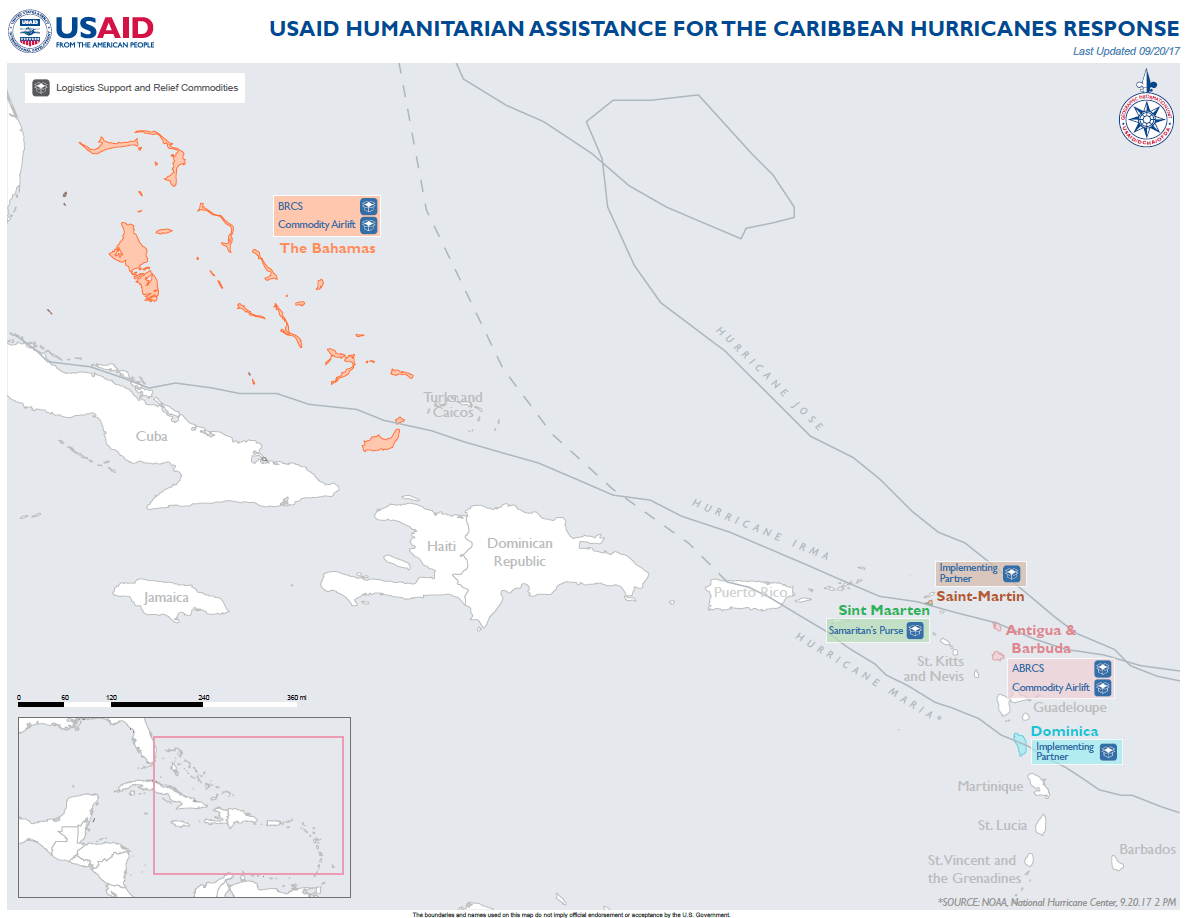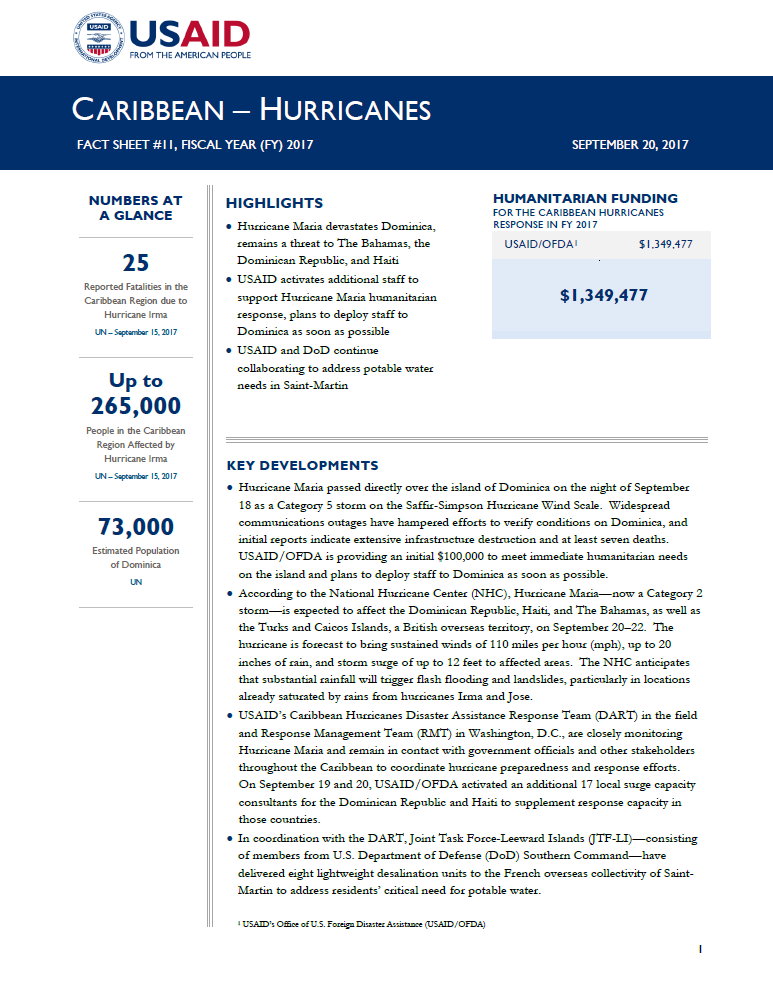September 20, 2017
Highlights
- Hurricane Maria devastates Dominica, remains a threat to The Bahamas, the Dominican Republic, and Haiti.
- USAID activates additional staff to support Hurricane Maria humanitarian response, plans to deploy staff to Dominica as soon as possible.
- USAID and DoD continue collaborating to address potable water needs in Saint-Martin.
Key Developments
Hurricane Maria passed directly over the island of Dominica on the night of September 18 as a Category 5 storm on the Saffir-Simpson Hurricane Wind Scale. Widespread communications outages have hampered efforts to verify conditions on Dominica, and initial reports indicate extensive infrastructure destruction and at least seven deaths. USAID/OFDA is providing an initial $100,000 to meet immediate humanitarian needs on the island and plans to deploy staff to Dominica as soon as possible.
According to the National Hurricane Center (NHC), Hurricane Maria—now a Category 2 storm—is expected to affect the Dominican Republic, Haiti, and The Bahamas, as well as the Turks and Caicos Islands, a British overseas territory, on September 20–22. The hurricane is forecast to bring sustained winds of 110 miles per hour (mph), up to 20 inches of rain, and storm surge of up to 12 feet to affected areas. The NHC anticipates that substantial rainfall will trigger flash flooding and landslides, particularly in locations already saturated by rains from hurricanes Irma and Jose.
USAID’s Caribbean Hurricanes Disaster Assistance Response Team (DART) in the field and Response Management Team (RMT) in Washington, D.C., are closely monitoring Hurricane Maria and remain in contact with government officials and other stakeholders throughout the Caribbean to coordinate hurricane preparedness and response efforts. On September 19 and 20, USAID/OFDA activated an additional 17 local surge capacity consultants for the Dominican Republic and Haiti to supplement response capacity in those countries.
In coordination with the DART, Joint Task Force-Leeward Islands (JTF-LI)—consisting of members from U.S. Department of Defense (DoD) Southern Command—have delivered eight lightweight desalination units to the French overseas collectivity of Saint-Martin to address residents’ critical need for potable water.
Caribbean Hurricanes - Map #11 ![]() (pdf - 269k)
(pdf - 269k)
Numbers At A Glance
25
Up to 265,000
73,000
Humanitarian Funding
For the Caribbean Hurricanes in FY 2017
| USAID/OFDA | $1,349,477 |
Caribbean Hurricanes - Fact Sheet #11 ![]() (pdf - 189k)
(pdf - 189k)
DOMINICA
On the night of September 18, Hurricane Maria passed directly over Dominica as a Category 5 storm on the Saffir-Simpson Hurricane Wind Scale, causing catastrophic damage across the island. Dominica’s main hospital, the prime minister’s official residence, and many other buildings lost their roofs to the hurricane’s 160 mph winds, according to international media. Preliminary reports indicate at least seven storm-related fatalities, extensive road obstruction or damage across the island, and widespread outages of electricity, water supply, and telecommunications networks.
On September 19, U.S. Ambassador to Barbados and the Eastern Caribbean Linda S. Taglialatela issued a disaster declaration for Dominica due to the effects of Hurricane Maria. In response, USAID/OFDA is providing an initial $100,000 to address the priority needs of hurricane-affected populations. As soon as conditions allow, USAID plans to deploy DART staff to Dominica to conduct damage assessments, coordinate U.S. Government (USG) response efforts, and liaise with Government of the Commonwealth of Dominica officials, relief organizations, and other stakeholders. USAID/OFDA also activated a disaster risk management specialist and two local surge capacity consultants for Dominica ahead of the storm.
DOMINICAN REPUBLIC
The Government of the Dominican Republic (GoDR) declared a red alert—the highest level of a three-tiered system—for 11 provinces in eastern and northern parts of the country on September 20. Of the country’s remaining provinces, 15 are under a yellow alert, the second-highest alert level, and six are under a green alert, the lowest alert level.
As of September 20, a USAID/OFDA disaster risk management specialist (DRMS) and 12 local surge capacity consultants—assigned throughout the Dominican Republic—are tracking Hurricane Maria developments, as well as national and local hurricane preparedness and response efforts. One surge capacity consultant is liaising with the GoDR national emergency operations center (EOC) in the national capital of Santo Domingo.
According to USAID/OFDA staff in country, the EOC has ordered the evacuation of vulnerable communities in northern coastal areas and has deployed armed forces to assist with evacuations. The GoDR has activated 95 shelters in Santo Domingo and five shelters in the northern city of Puerto Plata.
HAITI
Recent heavy rains have caused localized floods in four northern departments in Haiti, USAID/OFDA staff in the country report. Additional rainfall associated with Hurricane Maria could potentially cause significant flooding in already saturated areas.
On September 19, USAID/OFDA and USAID Office of Food for Peace (USAID/FFP) staff based in the capital city of Port-au-Prince met with the Government of Haiti (GoH) Directorate of Civil Protection to discuss hurricane preparedness efforts. In addition, USAID/OFDA has placed a DRMS at the national EOC to facilitate coordination with GoH authorities.
In preparation for the potential impacts of Hurricane Maria, USAID/OFDA activated seven local surge capacity consultants in the departments of Artibonite, Centre, Nord, Nord-Est, and Nord-Ouest on September 20.
USAID/OFDA and USAID/FFP staff remain in contact with response partners, many of which have pre-positioned relief commodities ahead of Hurricane Maria. For example, the UN World Food Program (WFP) has pre-positioned high-energy biscuits—two-day rations for an estimated 40,000 people—in the northern city of Cap-Haïtien, as well as a contingency stock of rice, pulses, oil, salt, and other food items sufficient for an estimated 150,000 people for one month in Port-au-Prince.
ST. MARTIN
On September 19, Hurricane Maria passed more than 50 miles south of the island of St. Martin2 as it tracked across the northeastern Caribbean Sea. DART staff in Sint-Maarten reported minimal impacts from the tropical-storm-force winds and rainfall that the hurricane brought to the island. By the morning of September 20, the DART had resumed response activities.
Access to potable water remains a priority need in French Saint-Martin, and the DART and JTF-LI have coordinated to import and install lightweight water desalination units to improve residents’ access to water. Between September 14 and 18, the water desalination units installed by JTF-LI produced more than 22,000 gallons, or approximately 84,000 liters, of potable water.
On September 18, JTF-LI placed the eight lightweight water desalination units in Saint-Martin—four of which had arrived that day—into temporary storage to secure them for Hurricane Maria’s passage. JTF-LI began re-installing the units at two sites on September 20; once operational, each four-unit site will have the capacity to produce approximately 6,000 gallons—or approximately 22,700 liters—of potable water per day. The DART and DoD continue to collaborate with the Government of France and local officials in Saint-Martin to facilitate access to safe water for hurricane-affected communities.
CONTEXT
Hurricane Irma—the strongest Atlantic hurricane on record—began affecting the eastern Caribbean in early September. On September 6, the hurricane made landfall over the island of Barbuda in the northeastern Caribbean before passing near The Bahamas, the Dominican Republic, and Haiti and making secondary landfall in Cuba on September 9. The hurricane brought destructive winds, heavy rainfall, and dangerous storm surge, resulting in at least 25 fatalities and causing significant infrastructure damage across the Caribbean region.
On September 9 and 10, Hurricane Jose passed north of the Leeward Islands and proceeded into the North Atlantic Ocean, causing minimal impacts in the Caribbean region.
On September 6, U.S. Chargé d’Affaires, a.i., Lisa A. Johnson issued a disaster declaration in response to the anticipated effects of Hurricane Irma in The Bahamas, and on September 7, U.S. Ambassador to Barbados and the Eastern Caribbean Linda S. Taglialatela issued a disaster declaration in response to Hurricane Irma and the anticipated effects of Hurricane Jose in Antigua and Barbuda. In response, USAID/OFDA contributed an initial $100,000 each to the Bahamas Red Cross Society and the Antigua and Barbuda Red Cross Society.
On September 7, USAID activated a regional DART and stood up a Washington, D.C.-based RMT to coordinate the USG’s humanitarian response to the hurricanes.
On September 9, U.S. Embassy in Paris Chargé d’Affaires D. Brent Hardt issued a disaster declaration for the French Saint-Martin, and on September 10, U.S. Embassy in The Hague Chargé d’Affaires Shawn Crowley declared a disaster for Sint Maarten due to the effects of Hurricane Irma and anticipated effects of Hurricane Jose. In response, USAID/OFDA contributed an initial $100,000 each for activities in Saint-Martin and Sint Maarten.
PUBLIC DONATION INFORMATION
The most effective way people can assist relief efforts is by making cash contributions to humanitarian organizations that are conducting relief operations. A list of humanitarian organizations that are accepting cash donations for disaster responses around the world can be found at www.interaction.org.
USAID encourages cash donations because they allow aid professionals to procure the exact items needed (often in the affected region); reduce the burden on scarce resources (such as transportation routes, staff time, and warehouse space); can be transferred very quickly and without transportation costs; support the economy of the disaster-stricken region; and ensure culturally, dietary, and environmentally appropriate assistance.
More information can be found at: USAID Center for International Disaster Information: www.cidi.org or +1.202.661.7710. Information on relief activities of the humanitarian community can be found at www.reliefweb.int.









Comment
Make a general inquiry or suggest an improvement.